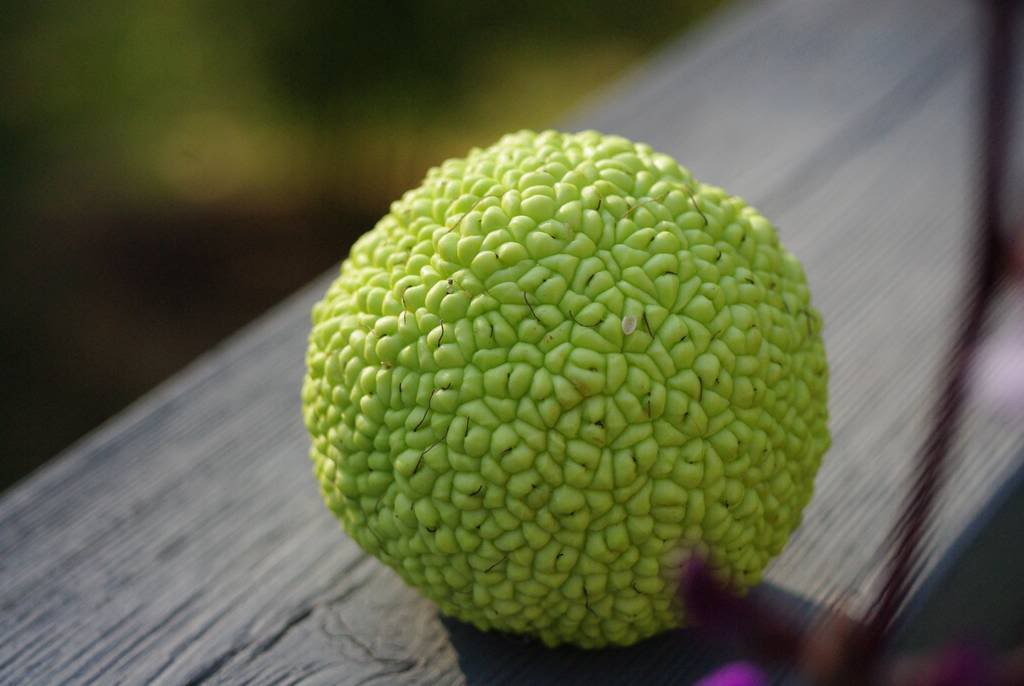I was handed this object yesterday and asked "what is it?" After all, I am the plant expert of the house. Unfortunately, all I could say was "some type of nut".
Google has failed me so far, and I'm not prepared to break it open yet to see if that helps me identify it, so I'm wondering: "what is it?"
I do love the bumpy, brain-like texture:
But please educate me: what is this?
(I guess I'll crack it open at some time, but I think I'll keep it around intact for a little while.)
.




I don't know what fruit it is, but am sure it is a multiple fruit. Each fruit has that remains of the style still there. I wonder if it is a relative of Artocarpus species. Maybe each fruit has a small seed inside.
ReplyDeleteosage orange, I think
ReplyDeleteI was going to say osage orange also, but it's hard to tell how big it is?
ReplyDeletehttp://en.wikipedia.org/wiki/Maclura_pomifera
ReplyDeleteYup - that's gotta be it!
It's an Osage orange as the others have said. A couple years back I bought a few as decorative items for a bowl on the table, be careful they can emit a sticky substance that's hard to clean up! Cool though eh? My husband's family had them growing on the farm back in Nebraska.
ReplyDeleteThanks all, definitely an Osage orange. Stickiness already noted. Maybe I'll put it out for the squirrels to eat, as it wouldn't look too nice in a bowl all by itself. :-)
ReplyDeletewe call'em hedge apples. Osage orange is the the tree, hedge apples are the fruit. some say the scent keep roaches away. not sure about that though.
ReplyDeleteOsage oranges are a great natural insect repellent in the garage or basement. Cut into pieces and throw them in an unobtrusive place.
ReplyDeleteOsage orange wood is very dense and withstands rot so we use it quite extensively for perches or propping inside animal exhibits.
ReplyDeleteKathy: not sure about that claim. From U of Nebraska website:
ReplyDelete"The belief about the use of hedge apples for insect control is widespread and persistent. it is claimed that placing hedge apples around the foundation or inside the basement will repel or control insects. A few years ago, Iowa State University toxicologists extracted compounds from hedge apples. When concentrated, these compounds were found to repel insects.
Scientists also found that natural concentrations of these compounds in the fruit were too low to be an effective repellent. So, don't be fooled into spending much to use hedge apples as an insect repellent."
It's certainly a hedge apple, also known as an Osage orange. They come into season late summer/early fall. In Kansas, early settlers used hedge trees as row lines to delineate the boundaries of their farmsteads since there was not an abundance of trees for wood fences. Many of these tree lines still exist. I live in the suburban KC area and it's not uncommon to still find a row of hedge trees in the backyards where two different subdivisions meet. The developers left the trees in place when fields and pastures were turned into residential neighborhoods. Supposedly the hedge apple repels spiders but it's probably an old wives tale.
ReplyDeleteheather is absolutely right. It is a hedge apple. Ol' Martha Stewart has used them in some of her autumn decorations. I think they are great!
ReplyDeleteI agree with the above, we had a neighbor, back in Nebraska, who used to give them to us to hang around the eaves of our house...they were supposed to ward off wasps...not entirely sure how ;-)
ReplyDeleteIt's quite pretty, really. If it had roots it would likely be a Euphorbia, the standard botanical rule being if it is weird and you don't know what it is, it's probably a Euphorbia. :)
ReplyDeleteHoover: nice! I'll remember that one, although you warm-climate gardeners get the really cool/weird Euphorbias. :-)
ReplyDeleteI found one of these when I was a kid . . . and I would have sworn it was breathing! Had me freaked out . . .
ReplyDeleteMaclura pomifera 100% / osage apple
ReplyDeleteWe call them 'horse apples' in north Texas. They come from the Bois d'arc tree.
ReplyDeleteYeah, Osage Orange. There are male and female trees and the female trees will still produce these oranges/horse apples/whatever you want to call them regardless of if they are pollinated are not. They just won't produce viable seed.
ReplyDelete